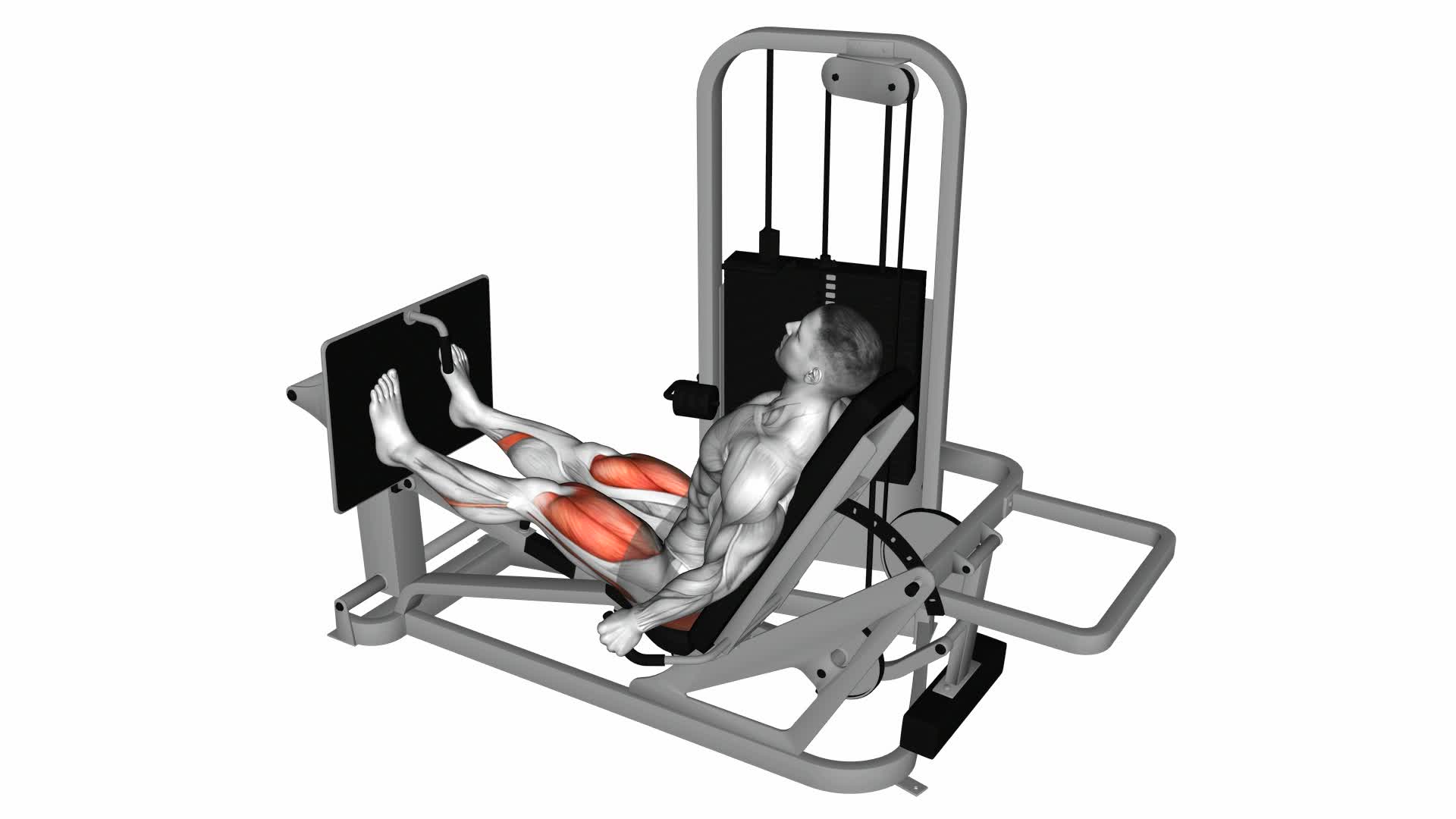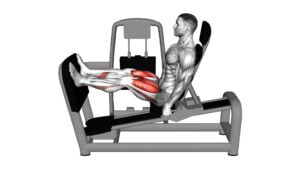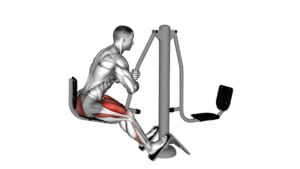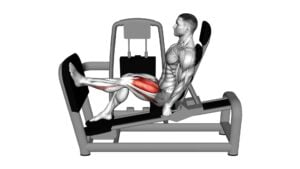Lever Seated Leg Press – Video Exercise Guide & Tips

Looking to strengthen your legs? Check out the lever seated leg press exercise!
Watch This Exercise Video
This video guide and tips will show you the proper setup and positioning, as well as the correct technique to maximize your results.
Avoid common mistakes and learn about the benefits of this exercise.
Plus, we'll share tips to increase intensity and progress.
Get ready to take your leg workouts to the next level with the lever seated leg press!
Key Takeaways
- Proper form and technique are essential for performing the lever seated leg press safely and effectively.
- The lever seated leg press targets multiple muscles including the quadriceps, hamstrings, glutes, calves, and hip adductors.
- The exercise provides a range of benefits such as building lower body strength, improving muscle endurance, enhancing leg power, and increasing bone density.
- Safety precautions should be followed, including starting with a light weight, avoiding locking knees, maintaining control throughout the exercise, and using a spotter if necessary.
Proper Setup and Positioning
To properly set up and position yourself for the lever seated leg press exercise, begin by adjusting the seat height and footplate distance. The seat height should be set so that when you sit down, your knees are at a 90-degree angle. This ensures proper alignment and reduces the risk of injury. The footplate distance should be adjusted so that your feet are shoulder-width apart. This allows for optimal stability and engagement of the leg muscles during the exercise.
Seated leg press variations are an effective way to target and strengthen your leg muscles, including the quadriceps, hamstrings, and glutes. By adjusting the seat position, foot placement, and resistance level, you can target different muscle groups and challenge your body in new ways.
Before starting any leg press exercise, it's important to warm up your muscles. A proper warm-up increases blood flow, raises body temperature, and prepares your muscles for the demands of the exercise. This can be done through dynamic stretches, such as leg swings or walking lunges, as well as light cardio exercises like jogging or cycling.
Taking the time to properly set up and warm up before performing the lever seated leg press exercise is crucial for maximizing its benefits and preventing injury. So, remember to adjust the seat height and footplate distance, explore different variations, and always warm up before your leg press workout.
Correct Technique for Leg Press
To execute the leg press exercise correctly, ensure that you position yourself with proper form and follow these steps. Firstly, adjust the seat so that your knees are aligned with the machine's pivot point. Place your feet shoulder-width apart on the platform, with your toes pointed slightly outward.
Next, release the safety handles and slowly lower the weight by bending your knees, keeping your back flat against the seat. Avoid locking your knees or rounding your back during the movement. Once your knees are at a 90-degree angle, push the weight back up by extending your legs, but don't fully lock out your knees at the top. Remember to exhale as you push the weight up and inhale as you lower it down.
Now, let's address some common leg press mistakes to avoid. One mistake is placing your feet too high or too low on the platform, which can put unnecessary strain on your knees or hamstrings. Another mistake is using too much weight, which can compromise your form and increase the risk of injury. Lastly, avoid fully locking out your knees at the top of the movement, as this can also increase the risk of injury and put excessive stress on your joints.
Additionally, there are variations of leg press exercises that you can incorporate into your workout routine. Some examples include single-leg presses, where you perform the exercise with one leg at a time, and wide stance leg presses, where you position your feet wider apart on the platform. These variations can help target different muscles and add variety to your leg training. Remember to always use proper form and start with lighter weights when trying new variations.
Common Mistakes to Avoid
Avoid These Common Mistakes When Performing the Lever Seated Leg Press.
To ensure you get the most out of your leg press workout and avoid injury, it's important to maintain proper form. One common mistake is placing your feet too high on the footplate. This can put excessive strain on your knees and reduce the effectiveness of the exercise. Instead, position your feet shoulder-width apart and ensure that your knees are aligned with your toes throughout the movement.
Another mistake to avoid is using too much weight. While it may be tempting to load up the machine, using excessive weight can lead to poor form and increase the risk of injury. Start with a weight that allows you to maintain proper form and gradually increase as you become stronger.
Lastly, avoid locking out your knees at the top of the movement. This can place unnecessary stress on your joints. Instead, keep a slight bend in your knees throughout the exercise, maintaining tension in your muscles.
Benefits of Lever Seated Leg Press
To get the most out of your lever seated leg press workout and continue reaping the benefits, it's important to understand the advantages of this exercise.
The lever seated leg press offers several advantages that make it a popular choice for leg training. Firstly, it provides a safe and controlled environment for working your leg muscles, as the machine guides your movements and reduces the risk of injury. Additionally, the lever seated leg press allows for a greater range of motion compared to other leg exercises, ensuring that you engage and activate your leg muscles more effectively.
This exercise primarily targets your quadriceps, but it also engages your glutes, hamstrings, and calves to a certain extent. By focusing on these major muscle groups, the lever seated leg press helps to build strength and size in your legs.
Furthermore, this exercise can be easily modified to accommodate your fitness level and goals, making it suitable for beginners and advanced athletes alike.
Now that you understand the advantages of the lever seated leg press, let's explore some tips for increasing intensity and progress in this exercise.
Tips for Increasing Intensity and Progress
Increase the intensity and progress of your lever seated leg press by incorporating these tips.
One way to make your leg press more challenging is by increasing the resistance. Start by adding small increments of weight and gradually work your way up. This progressive overload will stimulate your muscles to adapt and grow stronger over time.
Another tip is to vary your foot positioning. By changing the placement of your feet on the platform, you can target different muscles in your legs. For example, a narrow stance will target your inner thighs, while a wider stance will focus more on your outer thighs and glutes.
Additionally, you can incorporate different tempos into your leg press routine. Slow down the lowering phase of the movement to increase time under tension and really engage your muscles.
Finally, don't forget to maintain proper form throughout the exercise. Keep your back flat against the seat, your feet shoulder-width apart, and your knees in line with your toes.
Frequently Asked Questions
How Many Sets and Reps Should I Do When Performing the Lever Seated Leg Press?
When performing the lever seated leg press, it's important to determine the number of sets and reps that work best for you.
Sets and reps for the lever seated leg press can vary depending on your fitness level and goals. It's recommended to start with 3 sets of 10-12 reps, adjusting the weight and repetitions as needed.
This exercise is beneficial for strengthening your lower body, targeting muscles like the quadriceps, hamstrings, and glutes.
Can the Lever Seated Leg Press Help Me Build Muscle in My Upper Body?
The lever seated leg press primarily targets the lower body muscles, such as the quadriceps, hamstrings, and glutes. While it may indirectly engage the upper body muscles for stability, it isn't specifically designed to build muscle in the upper body.
To effectively build muscle in your upper body, it's recommended to incorporate exercises that directly target those muscle groups, such as bench presses, rows, and shoulder presses.
Is It Necessary to Use a Spotter When Performing the Lever Seated Leg Press?
When performing the lever seated leg press, you might wonder if using a spotter is necessary. While it isn't mandatory to have a spotter for this exercise, having one can provide several benefits.
A spotter can help ensure proper form, offer support in case you need assistance, and prevent any potential injuries. Having a spotter can give you peace of mind and allow you to push yourself to your limits safely.
Can the Lever Seated Leg Press Help With Improving My Balance and Stability?
Improving your balance and stability is a key benefit of the lever seated leg press.
This exercise targets your leg muscles, including the quadriceps, hamstrings, and glutes, which are essential for maintaining balance and stability.
By strengthening these muscles, you can improve your overall coordination and prevent falls or injuries.
The lever seated leg press is a great addition to your workout routine if you want to enhance your balance and stability.
Are There Any Alternative Exercises That Can Provide Similar Benefits to the Lever Seated Leg Press?
If you're looking for alternative exercises that offer similar benefits to the lever seated leg press, there are a few options to consider.
Lunges and squats are two excellent exercises that can help improve your balance and stability, while also targeting your leg muscles.
Additionally, step-ups and Bulgarian split squats are effective exercises that can provide similar benefits.
Incorporating these exercises into your routine can help you achieve your fitness goals.
Conclusion
In conclusion, the lever seated leg press is a highly effective exercise for strengthening and toning the lower body muscles. By following the proper setup and technique, and avoiding common mistakes, you can maximize the benefits of this exercise.
Additionally, by gradually increasing the intensity and progressing in your workouts, you can continue to challenge your muscles and see ongoing improvements.
Incorporating the lever seated leg press into your fitness routine can help you achieve your leg strength and conditioning goals.

Author
Years ago, the spark of my life’s passion ignited in my mind the moment I stepped into the local gym for the first time. The inaugural bead of perspiration, the initial endeavor, the very first surge of endorphins, and a sense of pride that washed over me post-workout marked the beginning of my deep-seated interest in strength sports, fitness, and sports nutrition. This very curiosity blossomed rapidly into a profound fascination, propelling me to earn a Master’s degree in Physical Education from the Academy of Physical Education in Krakow, followed by a Sports Manager diploma from the Jagiellonian University. My journey of growth led me to gain more specialized qualifications, such as being a certified personal trainer with a focus on sports dietetics, a lifeguard, and an instructor for wellness and corrective gymnastics. Theoretical knowledge paired seamlessly with practical experience, reinforcing my belief that the transformation of individuals under my guidance was also a reflection of my personal growth. This belief holds true even today. Each day, I strive to push the boundaries and explore new realms. These realms gently elevate me to greater heights. The unique combination of passion for my field and the continuous quest for growth fuels my drive to break new ground.







